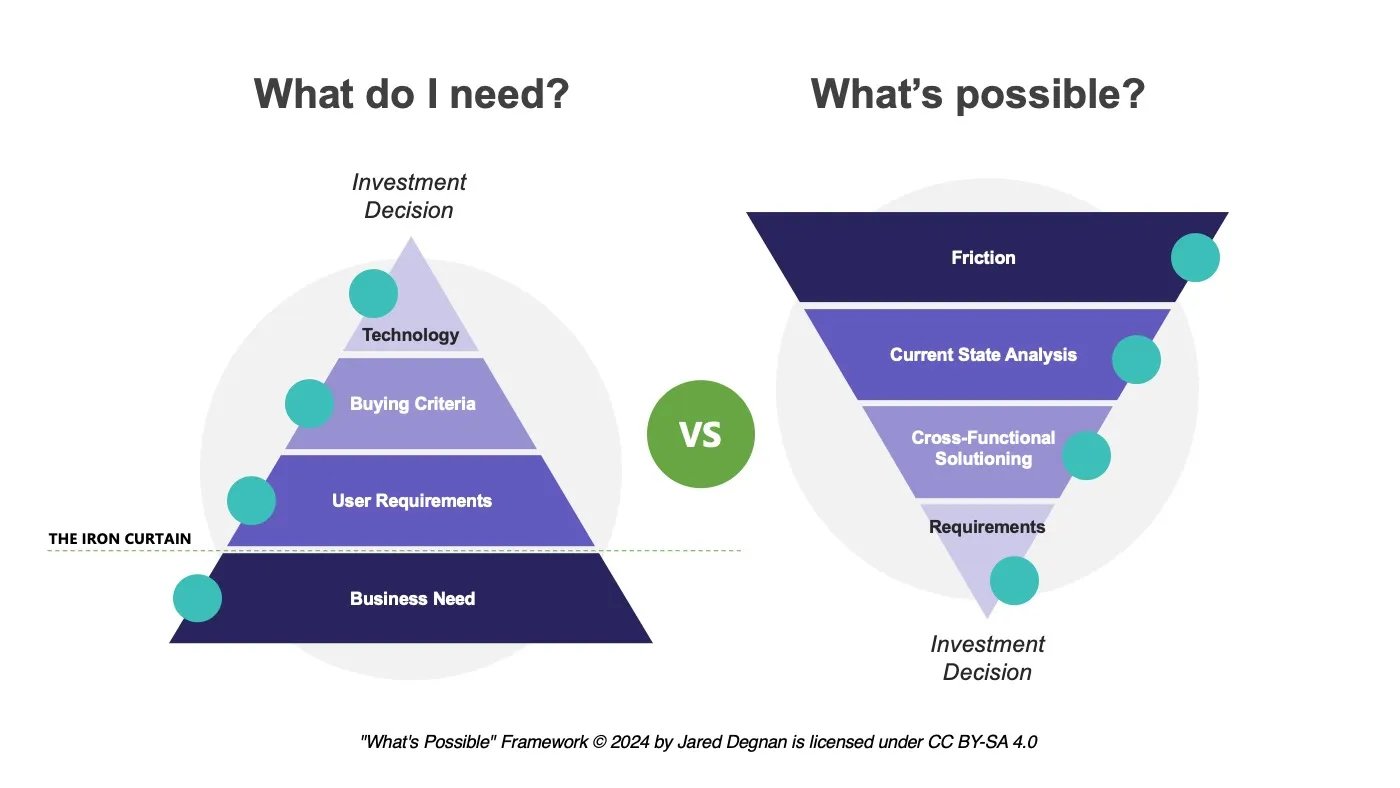How the Best Technologies Flip the Script With a Single Question
A whopping 40% of the technology investments that businesses make end in buyer’s regret.
Buyer’s regret is that nagging feeling that you just spent a lot of money on something that (1) wasn’t worth it, (2) doesn’t do what you thought it was going to do, or (3) doesn’t work with things you already have. Or — if you’re really unlucky — it’s all three.
But why does this happen? It’s not like senior business executives are running around purposely trying to waste two-fifths of their budgets.
These aren’t rash decisions either. Most enterprise technology buying cycles take three to six months and multiple rounds of stakeholder approvals.
Hypothesis
I have a theory about what’s going on and it’s all about the questions that are being asked. It isn’t about asking too few questions. It’s about failing to ask one specific question — “What’s possible?”
That single question — “What’s possible?” — can turn the whole technology solutioning process on its head.
Root Cause Analysis
Here’s what typically happens when developing technology solutions.
About 90% of technology discussions focus on what I’ve named “feature/functionality whack-a-mole.”
Feature/functionality whack-a-mole is the game that businesses and solutions providers play when they try to match a business’s needs with solutions. The problem with this approach is that there’s information asymmetry on both sides.
The business has valuable information — that could benefit the solutions provider — but doesn’t want to offer it (or doesn’t think to) because they are trying to manage their investment risks.
The solutions provider has valuable information — that could benefit the business — but doesn’t want to offer it (or doesn’t think to) because it could upset the sale.
It’s a cold war of information, complete with an “Iron Curtain” of distrust.
Most discoveries are limited to the area “above the surface,” the only area that the business wants the solutions provider to see. Either they don’t trust the solutions provider or they want to ensure that whatever technology they are going to buy doesn’t conflict with the technology that they already have.
Solutions Framework
Let’s say we flip the script here. What if we take what’s behind the curtain and start with that — but provide guide rails?
This is where our critical question comes in — “What’s possible?”
The question “what’s possible” helps create a framework to unlock innovative solutions.
Step 1 — Start With Friction
Instead of starting with buying criteria, start with identifying the friction at play. Friction — financial, operational, or human — suggests a problem to be solved.
Friction also provides two key functions. First, it offers you common ground to understand the other party. It isn’t about blame, or something being “broken” — friction is naturally occurring. Second, it provides you with a roadmap to create a solution that’s going to work for both parties in the long run.
Step 2 — Cross-functional Current State Analysis
Once you have identified the friction, that’s when you bring in your experts — not just technical experts but operational, financial, and experiential experts as well. Put them all in the same room and let them react to the friction.
Ask, “What’s really going on at every level?” Encourage teams to use “I feel” statements. What about the situation impacts the team functionally and emotionally?
That’s where you’re going to uncover the needs that might not have been uncovered if you were just playing feature/functionality whack-a-mole.
Step 3 — Cross-functional Solutioning
Here’s where the magic happens!
Instead of jumping straight into needs, ask those same cross-functional stakeholders what they want the situation to be like.
I like to call this the “magic wand” exercise. If you were given a magic wand, what would you do differently? What data would you want? What parts of the process would you like automated? What would you spend more of your time doing if you didn’t have to deal with the things that you don’t like about the current process?
This line of questioning is going to generate your user requirements and unlock a huge set of possibilities that you never knew you had. It’s also going to free up your solutions provider to consider solutions that might provide more flexibility than the prescriptive criteria you originally may have wanted.
Step 4 — Co-create Technology Requirements
Once the technology teams — both the vendor and your internal team — have the ideal “happy path,” sit down and whiteboard what the technical requirements are.
What systems need to be integrated? What should the data flow look like? What are the acceptance criteria for each use case?
If there’s a gap, you can talk about it openly and honestly without worrying about either party getting hurt.
The business can feel confident that the solutions provider is listening to them and not trying to be overly aggressive with the sale. The solutions provider can feel confident that they won’t be precluded from the overall sale because they have a chance to recommend options to fill the gap.
Conclusion
Rather than playing feature/functionality whack-a-mole, businesses and solutions providers can work together with the help of that one question — “What’s possible?”
That single question allows each party to better understand and trust each other, and the net result is something better than either party could have come up with on their own.
From my experience, this approach does take a bit longer, but it ultimately creates stronger partnerships, more innovative solutions, and better overall return on investment. Implementation is more streamlined, budgets don’t run over, and even the dreaded pitfalls of user acceptance testing can be eliminated.
Best of all, asking, “What’s possible?” dramatically reduces or eliminates buyer’s regret.


